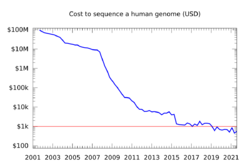Biology:Carlson curve

The Carlson curve is a term to describe the rate of DNA sequencing or cost per sequenced base as a function of time.[1] It is the biotechnological equivalent of Moore's law. Carlson predicted that the doubling time of DNA sequencing technologies (measured by cost and performance) would be at least as fast as Moore's law.[2]
History
The term was coined by The Economist[3] and is named after author Rob Carlson.[1]
Carlson curves illustrate the rapid (in some cases above exponential growth) decreases in cost, and increases in performance, of a variety of technologies, including DNA sequencing, DNA synthesis and a range of physical and computational tools used in protein production and in determining protein structures.
Next generation sequencing
Moore's Law started being profoundly out-paced in January 2008 when the centers transitioned from Sanger sequencing to newer DNA sequencing technologies:[4] 454 sequencing with average read length=300-400 bases (10-fold) Illumina and SOLiD sequencing with average read length=50-100 bases (30-fold).
References
- ↑ 1.0 1.1 Robert H. Carlson (April 2011). Biology Is Technology : The Promise, Peril, and New Business of Engineering Life. Cambridge, MA: Harvard University Press. http://www.hup.harvard.edu/catalog.php?isbn=9780674060159.
- ↑ Robert Carlson (September 2003). "The Pace and Proliferation of Biological Technologies". Biosecurity and Bioterrorism: Biodefense Strategy, Practice, and Science 1 (3: 203–214): 203–214. doi:10.1089/153871303769201851. PMID 15040198. http://www.kurzweilai.net/the-pace-and-proliferation-of-biological-technologies-2.
- ↑ "Life 2.0.". The Economist. August 31, 2006. http://www.economist.com/node/7854314.
- ↑ "DNA Sequencing Costs". National Human Genome Research Institute. http://www.genome.gov/sequencingcosts/.
 |


